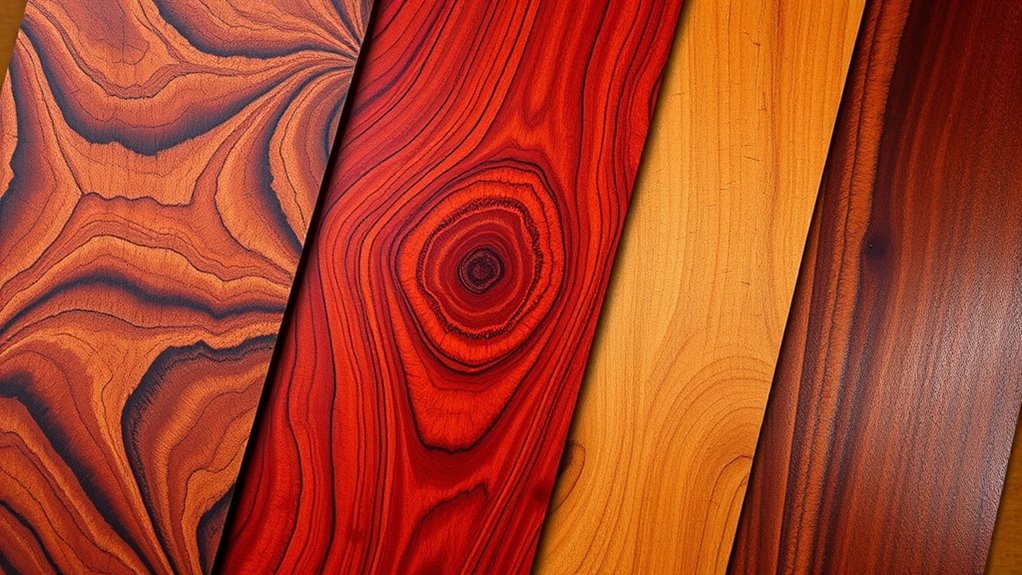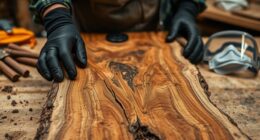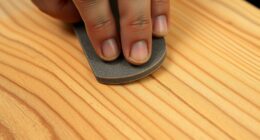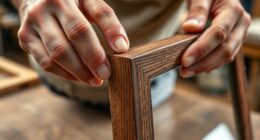Exotic woods stand out with their vibrant colors, unique grain patterns, and dense, durable nature, making them perfect for high-end furniture, flooring, musical instruments, and decorative pieces. Many types like Purpleheart, Ebony, and Jatoba offer beautiful natural finishes, resistance to wear, and stunning visual appeal. However, sourcing responsibly and understanding their challenges is essential. Keep exploring—there’s more to discover about how you can use these remarkable materials ethically and sustainably.
Key Takeaways
- Exotic woods feature unique colors, grain patterns, and textures that enhance visual appeal in furniture and decorative projects.
- They are known for high density and durability, making them ideal for flooring, cabinetry, and musical instruments.
- Many exotic woods possess natural resistance to pests and environmental factors, reducing maintenance needs.
- Responsible sourcing, certification, and sustainable harvesting are crucial to mitigate ecological and ethical concerns.
- Their challenging workability and finishing require specialized tools and techniques, emphasizing the importance of safety and proper handling.
Unique Attributes of Exotic Woods

Exotic woods stand out because of their vivid colors and distinctive grain patterns that you rarely find in domestic varieties. You might see striking purple hues in Purpleheart or bright orange-red in Padauk, while Ebony offers deep, rich dark shades. Their unique characteristics often reflect natural variation, which adds to their charm and individuality. Unique grain patterns like zebra-like stripes in Zebrawood or flowing, intricate designs in Desert Ironwood add visual interest and elevate your projects. These woods also feature natural luster and shine, especially in species like Ebony, making them perfect for decorative work. Additionally, their wood density influences how they are worked and finished, contributing to their desirability. The exotic origin of these woods often means they are harvested responsibly or sourced sustainably, further enhancing their appeal. The color stability of some exotic woods ensures they maintain their vibrant hues over time, making them ideal for heirloom pieces. Over time, some, like Padauk, darken and mellow, adding character. Their rarity and exotic origins contribute to their luxurious perception. Moreover, advances in sound design techniques have made exotic woods popular choices for crafting musical instruments, highlighting their acoustic qualities. This combination of vivid color, distinctive grain, and natural beauty makes exotic woods truly exceptional and highly sought after for creating distinctive, eye-catching pieces.
Popular Types of Exotic Woods
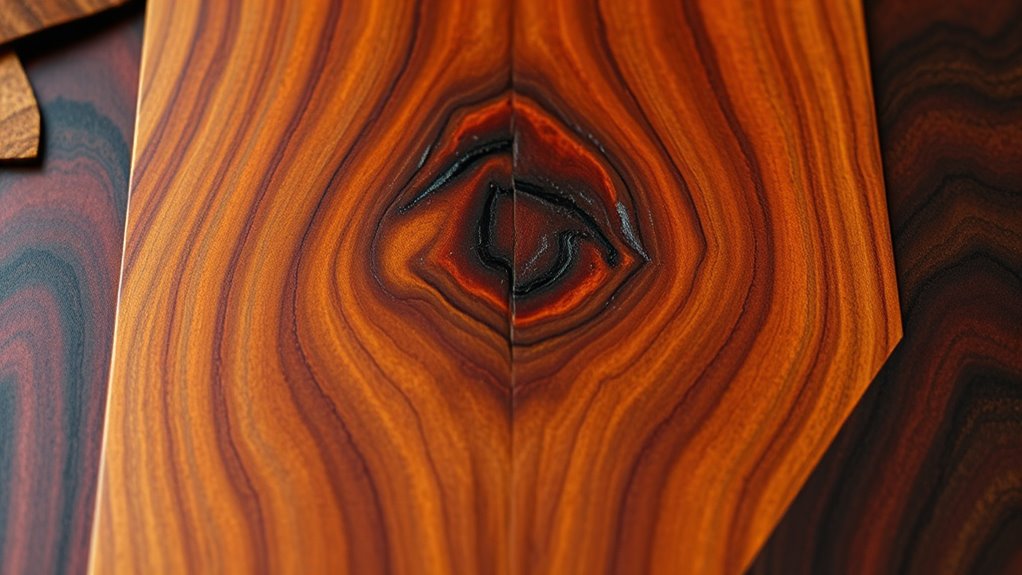
Many exotic woods stand out not only because of their striking appearance but also due to their exceptional durability and versatility. Cumaru, or Brazilian Teak, features a rich reddish-brown color and is highly resistant to insect damage and decay. It’s perfect for outdoor decking, flooring, and tool handles, thanks to its density and strength for heavy-use applications. Soil moisture check is essential when working with these woods if they are used in outdoor or humid environments to prevent warping or cracking. Proper moisture content management helps ensure the longevity of the wood in various conditions. Additionally, understanding the wood properties such as hardness and stability can guide proper selection and usage for different projects. For outdoor applications, selecting woods with high resistance to environmental factors ensures greater durability and performance. Maintaining appropriate moisture levels during storage and installation also helps prevent warping and splitting. Jatoba, known as Brazilian Cherry, offers a warm, reddish tone with dark streaks, making it ideal for flooring and furniture that need to withstand wear while adding natural elegance. Canary Wood displays a range of pale yellow to reddish-brown hues with eye-catching grain patterns, suitable for decorative items and exterior projects. Desert Ironwood and Katalox are among the hardest woods, with rich dark tones, used for tool handles, cabinetry, and premium crafts.
Common Applications of Exotic Woods
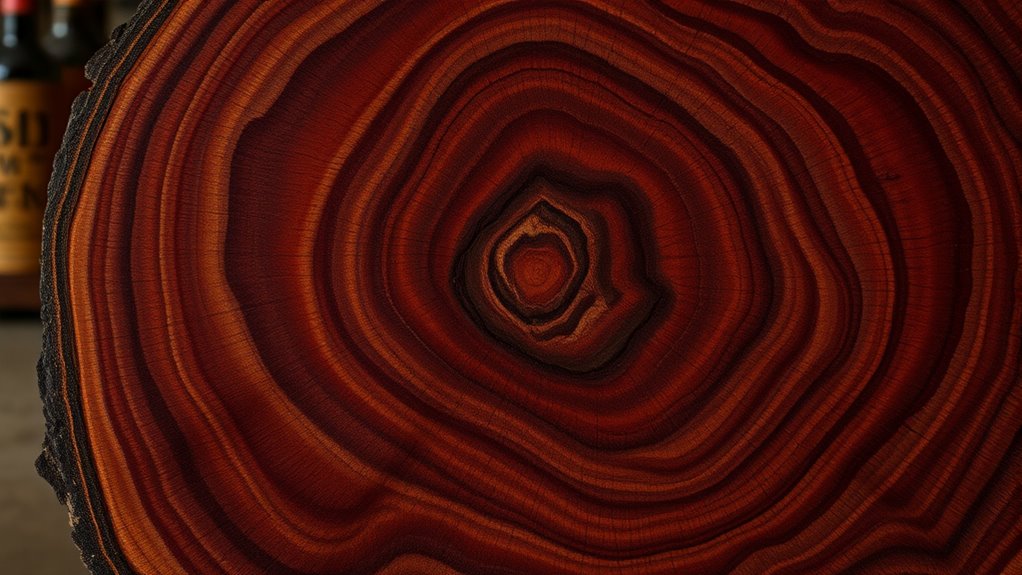
Exotic woods are prized not only for their striking appearance but also for their versatility in various applications. You’ll find them extensively used in furniture making, where their beauty and durability stand out. High-end woods like Bubinga and Purpleheart are popular choices for fine furniture pieces.
In cabinetry and veneers, woods such as Padauk and Zebrawood create decorative patterns and stunning finishes, making the most of their vibrant colors and unique grain. Their durability and aesthetic appeal contribute significantly to their popularity in decorative woodworking.
Exotic hardwoods like Ziricote and Padauk also shine in musical instruments, thanks to their durability and aesthetic appeal. These woods often possess exceptional acoustic properties, making them ideal for high-quality musical craftsmanship.
Additionally, woods like Spanish Cedar and Ipe are favored for flooring and decking, offering resistance to weather and pests. Their resistance to elements ensures long-lasting performance in outdoor settings. Proper maintenance can extend their lifespan even further.
For decorative items, dense woods like Red Ivory or Mahogany add a luxurious touch to accents and specialty products. The Vetted quality of these woods ensures they meet high standards for durability and appearance, making them suitable for both functional and decorative uses.
Benefits of Choosing Exotic Woods
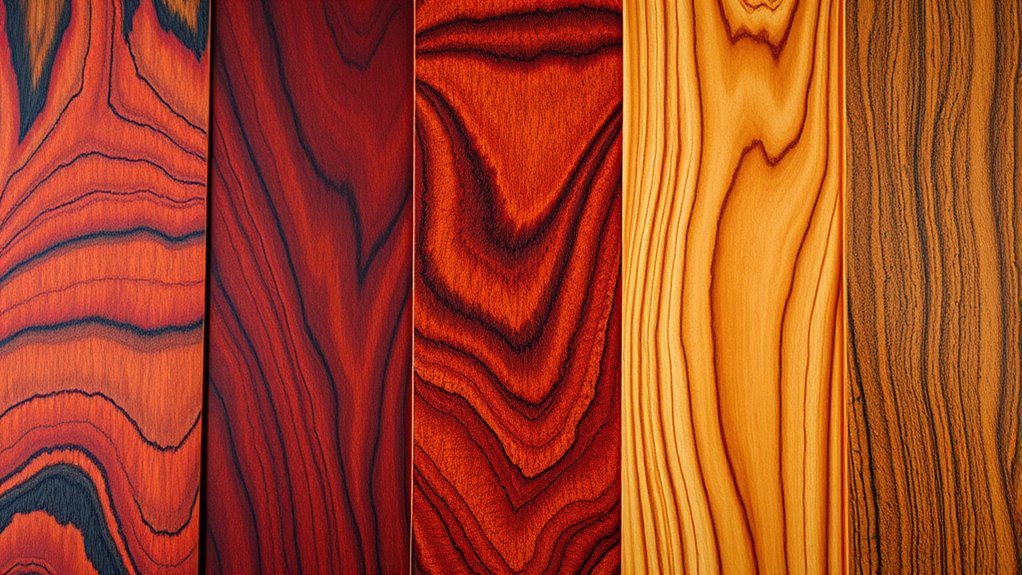
Choosing exotic woods offers remarkable benefits that elevate your woodworking projects. Their striking grain patterns and vibrant colors, like purples, reds, and deep browns, add sophistication and visual interest. With natural textures ranging from straight to wavy, you can create unique, eye-catching designs.
Exotic woods feature vibrant colors and unique textures that elevate your woodworking projects with elegance and distinction.
Exotic hardwoods are denser and harder than domestic woods, making them highly resistant to dents, scratches, and wear, which ensures long-lasting durability. Many species also resist moisture, pests, and decay, reducing maintenance and replacement costs.
Their natural oils and tight grains improve water resistance, making them ideal for outdoor use. Additionally, sourcing responsibly supports sustainable forestry, helping preserve ecosystems.
Using exotic woods not only enhances the beauty and longevity of your projects but also adds value and market appeal, making your creations truly stand out. Proper sourcing practices ensure you select sustainable and ethically harvested materials, supporting environmental conservation.
Challenges and Ethical Considerations
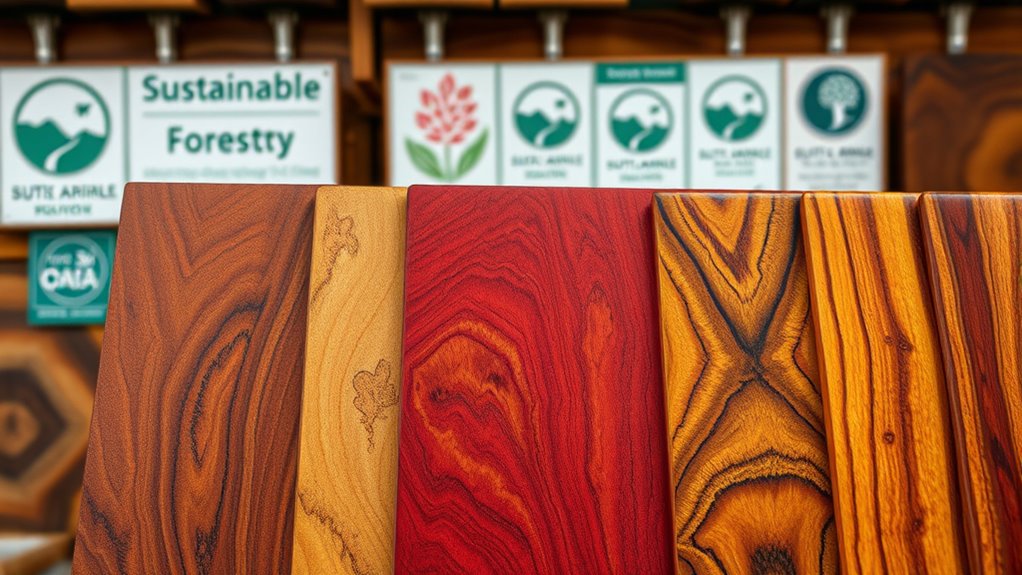
While exotic woods bring notable benefits to woodworking projects, they also pose significant challenges and raise ethical concerns. Their density and hardness quickly dull tools, requiring specialized equipment and careful handling to prevent tear-out and damage. Many species, like Teak and Rosewood, resist standard finishes, adding complexity to finishing work. Regulatory restrictions, such as CITES and permit requirements, slow procurement and increase costs, especially for endangered species like Ebony. Health risks from dust and toxic reactions demand strict safety measures, including ventilation and PPE. Ethically, illegal logging, habitat destruction, and slow species replenishment threaten ecosystems and communities. Limited certification options further complicate responsible sourcing. Additionally, understanding the sustainable harvesting practices for exotic woods is crucial for reducing environmental impact. Implementing traceability systems can help verify the legality and sustainability of exotic wood sources. Balancing these challenges with ethical considerations is vital to guarantee sustainable and safe exotic wood use.
Promoting Sustainability in Exotic Wood Use
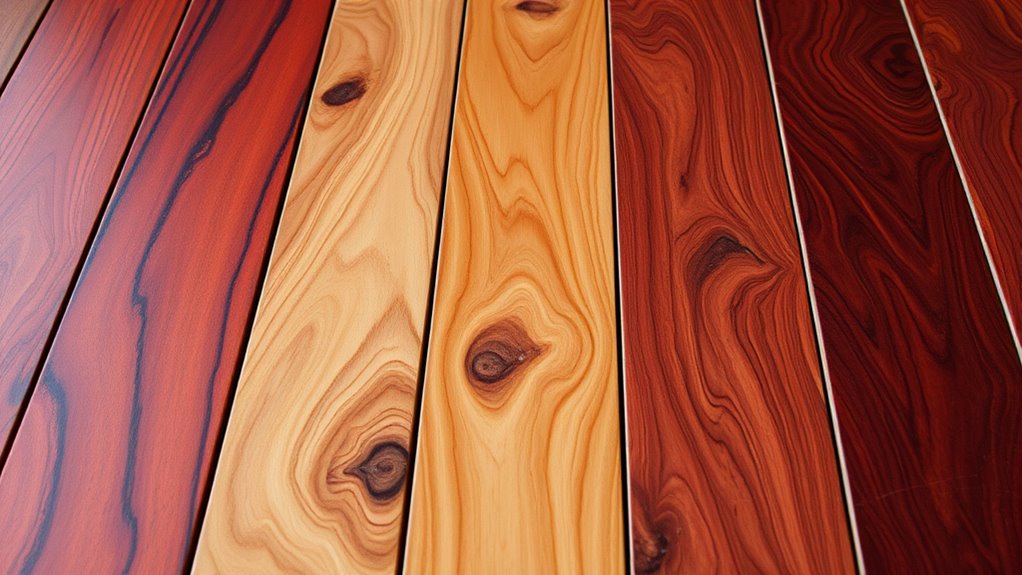
Promoting sustainability in exotic wood use involves adopting responsible sourcing practices and maximizing resource efficiency. By choosing woods certified by organizations like FSC, you guarantee materials come from well-managed forests that protect ecosystems and support local communities.
Prioritize suppliers who transparently disclose their sustainable practices to reduce illegal logging and deforestation risks. Reclaimed and salvaged woods from old furniture or structures extend the lifecycle of existing materials, reducing demand for new harvesting and supporting a circular economy. Incorporating auditory processing techniques into the selection process can ensure that materials meet safety and ergonomic standards for diverse users.
Additionally, opt for lesser-known, sustainably harvested species like Mopane or Chakte Viga to lessen ecological pressure. Considering domestic alternatives with similar qualities can also cut transportation emissions and bolster regional forestry. Understanding sustainable forestry practices involved in harvesting these woods can contribute to more responsible consumption and conservation efforts.
Implementing exotic wood market trends can help consumers make more informed decisions that support sustainable practices. Designing projects for durability and longevity further minimizes resource consumption and waste, fostering sustainable exotic wood use. Recognizing the importance of certified sustainable sources ensures that the environmental impact of exotic wood consumption remains minimal and ethically grounded.
Frequently Asked Questions
How Do Exotic Woods Compare to Domestic Woods in Maintenance Requirements?
When comparing exotic woods to domestic ones, you’ll find that exotics usually need less maintenance due to their natural resistance to decay, pests, and moisture.
They’re more durable, so you won’t have to refinish or treat them as often. Domestic woods might require regular sealing, finishing, or repairs, especially in humid environments.
Are There Any Health Risks Associated With Working With Exotic Woods?
You should know that working with exotic woods can pose health risks. Dust from woods like rosewood, padauk, and satinwood can cause respiratory issues, skin irritation, or allergic reactions.
Some, like sassafras, contain carcinogens. To stay safe, always wear PPE, guarantee good ventilation, and clean your workspace regularly.
Consider using less toxic alternatives when possible, and get medical checkups if you experience persistent symptoms.
What Are the Best Finishes to Preserve Exotic Wood Surfaces?
Did you know that applying the right finish can extend the lifespan of exotic woods by up to 50%?
To preserve their beauty, you should use marine varnish for outdoor projects, as it offers excellent UV and water resistance.
For indoor surfaces, oil finishes like Tung oil highlight grain, while polyurethane provides durability.
Shellac and lacquer are great as sealers or intermediate coats for enhanced adhesion and smoothness.
How Can I Identify Authentic Exotic Wood Versus Fake or Treated Materials?
To identify authentic exotic wood, start by examining the endgrain for natural growth rings, distinct ray patterns, and pore distribution under magnification.
Feel the texture and weight—real woods are denser and have tight grain, often with a unique aroma.
Use tools like a hand lens or microscope to observe cell structures, and check for irregularities that synthetics lack.
Always verify with reputable databases and certification to guarantee authenticity.
Which Exotic Woods Are Best Suited for Indoor Versus Outdoor Projects?
Did you know that some exotic woods like Ipe can last over 25 years outdoors?
For indoor projects, woods like Bubinga, Zebrawood, and Wenge shine due to their stability and striking appearance. They work well in furniture, cabinetry, and musical instruments.
Outdoors, choose durable options like Teak, Ipe, and Cumaru, which resist moisture and weather.
Your choice depends on durability, aesthetics, and the project’s exposure to elements.
Conclusion
Just like the timeless allure of a rare gem, exotic woods offer unmatched beauty and character. By choosing these extraordinary materials, you embrace a legacy of craftsmanship and nature’s artistry, reminiscent of the legendary craftsmanship of ancient artisans. Remember, your conscious selection can guarantee these treasures remain vibrant for generations. So, as you craft and create, think of yourself as a steward of nature’s most exquisite gifts—preserving their magic for the stories yet to be told.
